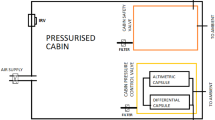Abstract
The method presented in the article is based on a complex simulation model of gas-dynamic processes that take place in sectioned cabins during depressurization. This model allows the theoretical calculation of decompression parameters (decompression time, cabin pressure, gas leakage from the cabin) depending on flight parameters and design features of the aircraft pressurised cabin (height, cabin volume, defect area, etc.) and determine the interdependence of pressure control parameters in critical operating modes. In computational experiments simulating decompression during depressurisation, the rate of cabin pressure drop as a function of the defect area, residual overpressure, decompression time, values of drops between compartment sections and mass flow rate during pressure changes; safe descent height and other parameters were determined. On the basis of computational experiments, a methodology for assessing the portability of decompression was developed, taking into account different levels of impact tolerance, allowing for a rational choice of hermetic and gas dynamic parameters of the cabin, as well as flight performance characteristics, taking into account the possible decompression of the cabin in flight or, conversely, with the specified parameters of the cabin and flight data at the design stage of the aircraft to assess the degree of danger in case of depressurization and to provide in advance a set of security measures. The transition for decompression safety analysis along the Chadov V. I. curve has advantages since it is applicable for various types of aircraft from spacecraft to aircraft and for various atmospheres with different combinations of pressures and concentrations.



Similar content being viewed by others
Data availability
The datasets used and analyzed during the current study are available from the corresponding author on reasonable request.
References
Koenchi EB (1960) Decompression phenomena on artificial satellites with living beings on board. In: Man under conditions of high altitude space flight: collection of translations from foreign periodic literature, Moscow, pp 349–416
Matyushev TV, Dvornikov MV, Petrov MA, Noskov RG (2021) Theoretical analysis of decompression modes of the flight vehicle hermetic cabin during depressurization In: XLV Academic readings on cosmonautics, dedicated to the memory of Academician S.P. Korolev and other outstanding national scientists—pioneers of space exploration, Moscow, pp 165–169
Haber F, Clamann HG (1953) Physics and engineering of rapid decompression: a general theory of rapid decompression. U.S. Air Force School of Aviation Medicine, Rept. 3, Randolph Field, Texas
Demetriades ST (1954) On the decompression of a punctured pressurized cabin in vacuum flight. Jet Propuls 24(1):35–36
Mavriplis F. (1963) Decompression of a pressurized cabin. Can Aeronaut Space J 313–318
Langley M (1971) Decompression of cabins. Aircr Eng Aerosp Technol 43:24–25
Jakovlenko VS (1976) Method of calculating the excess pressure in human lungs resulting from cabin decompression. Kosmicheskaia Biologiia i Aviokosmicheskaia Meditsina 10(5):62–68
Schroll DW, Tibbals TF (1999) A program for analysis of rapid aircraft cabin decompression. In: SAFE Association 37th annual symposium proceedings, Atlanta
Breard C, Lednicer D, Lachendro N, Murvine E (2004) A CFD analysis of sudden cockpit decompression. In: 42nd AIAA aerospace science meeting and exhibit. AIAA Paper 2004-0054, Reno
Daidzic NE, Simones MP (2010) Aircraft decompression with installed cockpit security door. J Aircr 47(2):490–504
Pratt JD (2006) Rapid decompression of pressurized aircraft fuselages. J Fail Anal Prev 6(6):70–74. https://doi.org/10.1361/154770206X156268
Pagani A, Carrera E (2016) Gasdynamics of rapid and explosive decompressions of pressurized aircraft including active venting. Adv Aircr Spacecr Sci 3(1):77–93. https://doi.org/10.12989/aas.2016.3.1.077
Ivlentiev VS (1983) Depressurization of aircraft cockpits. Dissertation, MAI
Ilyushin YS, Olyzarov VV (1972) Systems of life support and rescue of aircraft crews, Moscow
Akopov MG, Bekasov VI, Dolgushev VG (2005) Aircraft equipment systems, 3rd edn. Moscow
Bykov LT, Egorov MS, Tarasov PV (1985) High altitude equipment of aircraft, Moscow.
Bykov LT, Ivlentiev VS, Kuznetsov VI (1972) High-altitude equipment of passenger aircraft, Moscow
Deitsch ME (1961) Technical gas dynamics, Moscow
Tarasov VV (2016) Calculation of ideal gas flow time from a constant volume tank into a constant pressure medium during adiabatic process. Vestnik Tyumenskogo gosudarstvennogo universiteta. Fiziko-matematicheskoe modelirovanie. Neft', gaz, energetika 2(2):84–95
Matyushev TV, Dvornikov MV, Ryzhenkov SP, Petrov MA (2021) Analysis of the body gas exchange indicators in high-altitude flight on the basis of the static model of the respiratory system. In: AIP conference proceedings. https://doi.org/10.1063/5.0036005
Matyushev TV, Dvornikov MV, Petrov MA (2021) Simulation of respiratory reactions of the human body during simulation of barometric pressure drop in a pressurized volume. Pilotiruemye polety v kosmos 38(1): 89–106. https://doi.org/10.34131/MSF.21.1.89-106
Chadov VI (2005) Experimental-theoretical justification of decompression safety of extravehicular activity of crews of manned space objects. Dissertation, Moscow I: Avtoreferat dissertatsii … doktora meditsinskikh nauk, Moscow
Malkin VB (1975) Barometric pressure. Gas composition. In: Basics of space biology and medicine. V. II. Book 1. Ecological and physiological foundations of space biology and medicine. Moscow, pp 11–73
Rudny IM, Vasiliev PV, Gozulov SA et al (1986) Aviation medicine: a manual, Moscow
Funding
The authors did not receive support or funding from any organisation for the submitted work.
Author information
Authors and Affiliations
Contributions
All authors were involved in the conception and design of the study. Preparation of the material was done by AR, IM and AM. The first draft of the manuscript was written by TM and MD, and all authors commented on previous versions of the manuscript. All authors read and approved the final version of the manuscript.
Corresponding author
Ethics declarations
Conflict of interest
The authors declare that they have no conflict of interest.
Rights and permissions
Springer Nature or its licensor (e.g. a society or other partner) holds exclusive rights to this article under a publishing agreement with the author(s) or other rightsholder(s); author self-archiving of the accepted manuscript version of this article is solely governed by the terms of such publishing agreement and applicable law.
About this article
Cite this article
Matyushev, T., Dvornikov, M., Maximova, I. et al. Theoretical analysis of decompression tolerance based on a simulated depressurisation model of an aircraft’s pressurised cabin. AS (2023). https://doi.org/10.1007/s42401-023-00262-1
Received:
Revised:
Accepted:
Published:
DOI: https://doi.org/10.1007/s42401-023-00262-1




